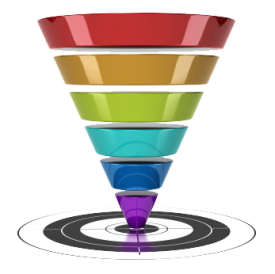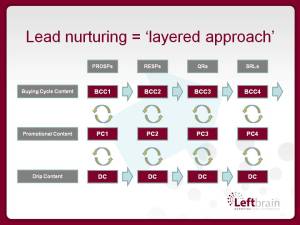B2B commerce in the U.S. is a big deal.
- The most-recent U.S. Census Bureau survey on the topic reported in 2008 that B2B commerce accounted for 52% of total commercial activity, and B2B e-commerce accounted for 92% of total e-commerce.
B2B marketing in the U.S. (also) is a big deal.
- B2B marketing represented 35% of total spending on marketing and advertising in the U.S. in 2010 – to the tune of $129B – according to research firm Outsell.
In fact, you might even make a credible argument that much of the innovation at a people, process, content and technology level in the overall marketing discipline, today, is primarily taking place in the B2B marketing and sales segment. Definitely more than in the consumer marketing arena.
Yet it seems more difficult than ever for B2B marketing and sales leaders to get the education and peer insight they need to stay ahead of their game. And, whereas the consumer world seems to have a real ‘esprit de corps,’ the idea of ‘community’ in the B2B marketing and sales world is a rare thing.
… which is why I’m so excited about the first-ever B2BCamp (Twitter: @b2bcamp, #b2bcamp #atl) in Atlanta this coming Saturday, March 10.
Billed as an ‘unconference,’ the event is squarely targeted at delivering the type of education, peer insights and community that too often seem to elude B2B marketing and sales leaders.
I’m also excited to be keynoting the event – giving a talk that is based on my book, Balancing the Demand Equation, and that frames up the day by talking about the larger set of challenges and opportunities facing B2B demand generation today.
An UnConference
So what is B2BCamp? The organizers explain:
B2BCamp is a user organized gathering focused on B2B Marketing topics. B2BCamp is one of many “unconferences” held throughout the world. Although similar to traditional industry conferences, at B2BCamp there are no “attendees” because everyone participates in some manner. Some participants will present while others will lead a roundtable discussion. Some will contribute simply by sharing their experiences and others by helping with logistics, securing sponsorships, setting up Wi-Fi, etc. B2BCamp is a self-organizing collaborative event that is rewarding, fun and a totally cool experience!
And if it’s not 100% apparent, B2BCamp – despite a focus on the topic of B2B commerce – is in fact not a commercial event. I.e., all of the organizers are volunteers, and sponsorships are set at a low level … just enough to help cover costs.
Vote for Your Favorite Session … and It May Make It on the Agenda
A key feature of B2BCamp is that the agenda is developed by the attendees via two rounds of voting – before the event to narrow the presentations and on-site to finalize the agenda.
In fact, you can review the proposed sessions and vote online here.
BTW: At the time I’m typing this blog post the top session is “Welcome to the Buyer-centric Movement” – a topic I love because it’s literally one of the two guiding concepts in my book.
Find Out Who Will Be There
Not only is this unconference transparent about selecting the sessions, it’s also transparent about who’s attending.
To find who’s attending, click here.
Worth a Full Saturday
As I mentioned above, the event is this Saturday, March 10, near the Perimeter Mall in the Atlanta area.
The event organizers tell me there are 175+ B2B marketing and sales leaders already registered, and so it’s likely to be a sell-out.
See you there.
Should be a good first step towards building a (much-needed) B2B marketing and sales community … in the Atlanta-area, and then around the country as B2BCamp hits the road! TBD.



 I’m very excited about working with Malcolm Friedberg, Robert Moreau, Sandra Syrett and the rest of the team at Left Brain Marketing. I believe this move will put me in a better position than ever to help B2B marketers develop successful, buyer-centric demand generation programs and build their brands in a bottoms-up, grassroots fashion – what I believe are the keys to achieving sustainable revenues in the modern B2B marketing environment. I also believe that Left Brain Marketing represents the right type of agency at the right time in the B2B marketplace. Its focus is on demand generation; it blends strategy with execution, partnering with its clients to design and execute programs; it recognizes that process change does not occur over night, establishing long-term relationships with its clients; it leverages marketing automation technology but is vendor agnostic; it believes successful marketing programs emerge from focusing on buyers and working with smart people; and it blends big consultancy brains with small agency touch.
I’m very excited about working with Malcolm Friedberg, Robert Moreau, Sandra Syrett and the rest of the team at Left Brain Marketing. I believe this move will put me in a better position than ever to help B2B marketers develop successful, buyer-centric demand generation programs and build their brands in a bottoms-up, grassroots fashion – what I believe are the keys to achieving sustainable revenues in the modern B2B marketing environment. I also believe that Left Brain Marketing represents the right type of agency at the right time in the B2B marketplace. Its focus is on demand generation; it blends strategy with execution, partnering with its clients to design and execute programs; it recognizes that process change does not occur over night, establishing long-term relationships with its clients; it leverages marketing automation technology but is vendor agnostic; it believes successful marketing programs emerge from focusing on buyers and working with smart people; and it blends big consultancy brains with small agency touch.






